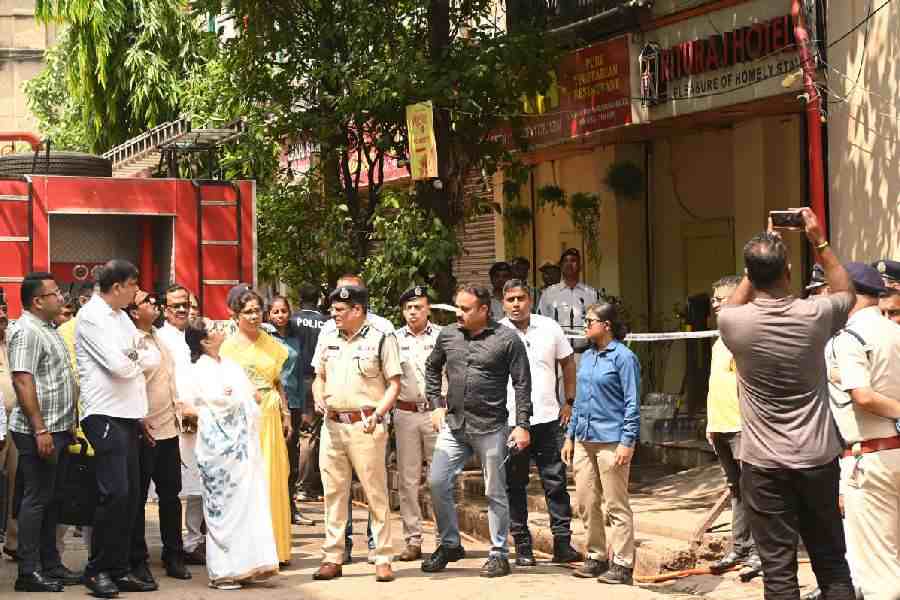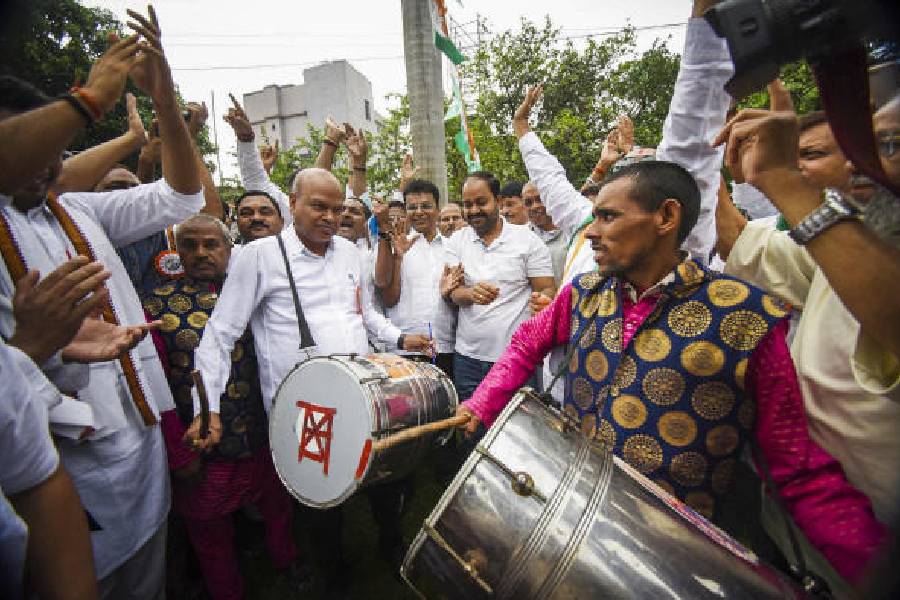 |
| Santhals dance during a festival in Birbhum, West Bengal; (below) map showing the routes of migration of the different Austro-Asiatic linguistic sub-groups of India |
 |
The next time Indian interlocutors engage their counterparts in Southeast Asian countries as part of the country’s “Look East” policy, they may have a better way to relate to them.
No, we are not talking of the spread of Hinduism or Buddhism — religions that originated in India — to that part of the world. This one goes far beyond — to be exact, some 40,000 years back.
Indian scientists have unearthed a vital genetic clue to establish that early settlers on Indian soil — tribes such as the Santhals and Mundas of West Bengal and Jharkhand — and native populations in many Southeast Asian countries share a common ancestry.
Researchers at the Indian Statistical Institute (ISI), Hyderabad, and others working in association claim they have picked up a pattern in the tiny variations in the DNA sequence that occurred in the past to show that early Indian males “populated” many Austro-Asiatic communities in Southeast Asia.
Austro-Asiatic tribes are present in many Southeast Asian countries, with most of the populations of Vietnam, Cambodia and Laos falling in this linguistic category. Tribes Kensui and Jehai of Malaysia, Lawa, Mlabari and Mon of Thailand and Zhuang, Yao and Miao of South China, too, belong to this group.
In India, the Austro-Asiatic linguistic group is considered the oldest and there is enough scientific proof to date its existence back to 65,000 years. The other predominant linguistic groups are Dravidian, Indo-European and Tibeto-Burman.
Indian Austro-Asiatic tribes are scattered across the Chhotanagpur plateau in Central and Eastern India, the Northeast and Andaman and Nicobar Islands. The oldest among them are the Mundari-speaking tribes from the Chhotanagpur region such as Santhal, Munda, Korwa and Kharia.
To track this exciting migratory route of Indian Austro-Asiatic men, the researchers — led by Dr. Battini Mohan Reddy of ISI’s Biological Anthropology Unit — looked at the variations in the Y chromosome using blood samples from more than 1,200 individuals from 25 Indian tribes belonging to these three distinct regions. They compared these with similar genetic data from over 200 populations, both Austro and non-Austro-Asiatic, from East and Southeast Asia.
Their studies showed that the haplogroup -M95 originated in the Indian Austro-Asiatic population some 65,000 years ago, and that their ancestors carried it further to Southeast Asia via the northeastern parts of the country. Haplogroups denote the branches of the tree of early human evolution and genetic evolution. Collectively, these are a set of genetic mutations or markers that link members of a particular ethnic group back to the first appearance of the marker, often thousands of years ago and in a totally unrelated geographical milieu.
While the scientists spotted a distinct correlation between the Y chromosomes of Austro-Asiatic communities in India and those in Southeast Asia, there wasn’t any clear-cut genetic evidence to prove any formidable maternal genetic link.
“This has led us to the conclusion that the ancestors of the present day male members of Indian Austro-Asiatic sub-groups moved to Southeast Asia through the Northeast Indian corridor,” Reddy told KnowHow. The scientists found that the -M95 haplogroup in Austro-Asiatic tribes based in the Chhotanagpur plateau region is 65,000 years old while the age of -M95 was estimated to be much younger in Southeast Asia, clearly indicating the migration pattern.
Anthropologists and population geneticists have always suspected that India served as a major corridor for the initial movement of people into Southeast Asia. “And this is what we have been able to prove,” says Vikrant Kumar, the first author of the paper that recently appeared in the journal BMC Evolutionary Biology. A research student of Reddy, Kumar is currently a post doctoral fellow at the Genome Institute of Singapore. He is working on a project that seeks to understand the population structure of Asia by studying the genetic mutations in 72 different populations of Asia.
However, it is still believed that there could have been a wave of migration prior to the movement of Austro-Asiatics to the Southeast Asian region. This could have been by Negritos, who are genetically closer to the early Africans. About two years ago, a research group at the Centre for Cellular and Molecular Biology (CCMB), Hyderabad, along with others found that the Great Andamanese and the Onge tribes are the direct descendants of modern humans who evolved in East Africa some 1,50,000 years ago. This study also indicated that the Andaman tribes arrived in the islands about 65,000 years ago, around the same time that the Austro-Asiatics reached India via the Eurasian route. Interestingly, some of the members of this group at CCMB are also co-authors of the current paper.
“The study is certainly interesting. But linking languages and people is risky,” says Ramasamy Pitchappan, professor at Madurai Kamaraj University in Tamil Nadu, who is currently regional director for India for the Genographic Project, an ambitious project funded by the National Geographic Society and IBM Corporation that seeks to explore early human migration and ancestry through genetic markers. For instance, he says, all those who speak Dravidian languages in South India are not necessarily Dravidians. This is because language itself emerged only 10,000 years ago.
Another interesting find that emerged from the study is that the scientists now know how the Indian Austro-Asiatic subgroups living in three pockets — the Mundari-speaking tribes of Central and Eastern India, the Khasi-Khumic-speaking Khasi tribe of Meghalaya, and the Mon-Khmer-speaking Nicobarese and Shompen tribes of Nicobar Islands — are related. The Khasis are the only Austro-Asiatic tribe in the Northeast, which is inhabited mainly by groups belonging to the Tibeto-Burman linguistic family, who are in turn believed to have come from East Asia.
Similarly, the study also pointed out that the Nicobarese tribe of Andaman and Nicobar Islands migrated from Southeast Asia some 18,000 years ago. The scientists came to this conclusion as they estimated the age of the -M95 haplogroup among the Nicobarese to be approximately 18,000 years.










